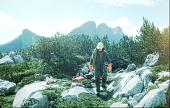 Simon Farrow at the entrance of 76 during the initial exploration in 1977
Simon Farrow at the entrance of 76 during the initial exploration in 1977
| 76 a b c4 | Eislufthöhle | 5/S/E + |
|---|
Altitude: 1643m Depth approx 506m
Location: Out on the plateau near some very large erratic boulders.
Laser rangefound point 0/6 is between the three entrances, and is at :
E 35873.1 N (52)82944.3 H 1647.8
calculated from surface survey from 0/4 we get :
E 35868.8 N (52)82934.2 H 1644.3
for the 76a entrance, which actually fits very well.
 Simon Farrow at the entrance of 76 during the initial exploration in 1977
Simon Farrow at the entrance of 76 during the initial exploration in 1977
Two snow plugged dolines (76 b & c) and a narrow shaft (76a) unite in a narrow rift leading to a windy lifelining position, Draught Bitter, at the head of a 72m shaft plugged with snow. Rigging Plugged Shaft between snow and rock, pitches in 1977 were 18m to a snow platform, 12m to a ledge, then 29m to a substantial ledge, Yesterday's Terminus. In 1979, with changed snow topography, and rigging for SRT, the drops were 11, 7, 17 and 19m to Yesterday's Terminus where a traverse out reaches a bolt for the final 13m drop onto a snow pile in a large aven chamber. A further 13m pitch, Saved Shaft, into a smaller aven chamber, Boulder Chamber, leads to an apparent end, but thrutch through boulders into top of rift/canyon. Hole in floor is 32m pitch into Keg Series (no draught) with further unexplored pitch below. Continuing traverse leads to climbs down then split pitch of 19m and 14m, Follow-through Shaft, dropping into side of abandoned canyon. Upstream to the left ends immediately while down canyon leads to head of a chamber, The Taproom, with a 5m climb down a big boulder under heavy drip/spray (handline useful). Also from the head of the chamber, passage leads back to a large unexplored hole in floor with lots of water entering from a high aven. 1977 terminus at -150m.
From chamber, scramble down in rift (rope useful owing to greasy rock and 120 metre drop) to reach head of large rift pitch below jammed boulder. Pitch drops in two sections of 10m and 35m, with stream out of reach in canyon, to ledge where stream bed is crossed (traverse line). Further pitch of 10m leads to straddle climb up to rocking boulder, then traverse forward to good belays for 48m pitch. This lands on The Balcony where water runs away from obvious way on into a tight immature drain.
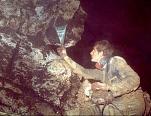
From the Balcony a 7m pitch drops into the Hall of the Greene King, a huge soaring aven chamber. The way on over a boulder floor leads under suspended boulders, one of immense size, to a 5m pitch down off the edge of a boulder. In the floor is a sharp canyon that loops round to a junction. Left leads to Gents' Pitch route, while right leads to a dry passage. After a few metres in the dry passage, there is a rift in the floor to the left, which is a muddy, broken pitch with sections of 3m, 12m and 18m into the main canyon (1978 route). Another few metres ahead, a bold step across the canyon leads to further passage which eventually degenerates and rejoins the main canyon upstream (right) of the bold step.
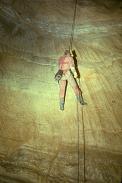
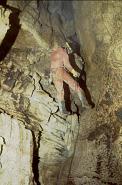
The 1979 route from the junction leads to a pitch of 16.5m, free hanging just clear of the wall, with an excellent takeoff. However the rope gets muddy from mud on clothing in a couple of trips, so care is required. Next drop is the Gents' pitch of 9.5m, which leads to a short streamway rejoining the main canyon from the 1978 route. The bottom of this pitch is a good place for cavers to perform ablutions with the mud on their ascenders, hence the name (all the explorers were male). The main passage now leads on with stream in floor and muddy ledges above until the Fiesta Run is reached. This awkward slanting rift pitch of 28m is so muddy that ladders are de rigeur. The name derives from the car crash which terminated exploration at this point in 1978.
A traverse forward on muddy ledges leads out over a huge shaft with the ominous sound of a waterfall below. Traversing further eventually leads to a further pitch of 5m to a col. Down another 10m on the side away from the main shaft lands on a solid floor in an abandoned rift. Forward leads through narrow passage with sharp rock to a point where thrutchy traversing is necessary to make further progress. A 23m broken pitch in sharp rock, with very bad rub points leads only to a tight crawl. This was pushed by Julian Griffiths to emerge at a drop with a large aven above, which remains unexplored at about -395m depth.
The main way on, however, is to drop back into canyon towards the ominous hiss of water in a very wide pitch where the stream seems to have hit a fault at right angles to the arriving passage direction. The middle section of this 28m pitch is huge, before narrowing to a ledge parallel to the new fault, and 'downstream' from the original direction of stream flow. From the ledge, a smaller shaft of 33m drops down the new fault rift to a boulder floor where the water sinks. The fault rift, Madlmeier Schacht, now drops in sections of 24 and 19m to the end of the rope in 1979. Here an exposed freeclimb of 5m with icy water flowing over the handholds is not really recommended - take a longer rope. Next pitch of 24m picks up the main water again 10m down, and final pitch of 17m from ledge drops to floor of rift chamber, but mud on floor precedes final muddy 10m pitch down a boulder wall to a deep and terminal rift sump at -506m.
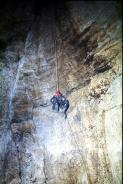 Simon Farrow on the last 17m pitch of Madlmeier Schacht
Simon Farrow on the last 17m pitch of Madlmeier Schacht
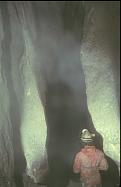 Julian Griffiths at the final sump - 1979
Julian Griffiths at the final sump - 1979
There are a number of going leads in this cave and you're welcome to them.
The entrance is prominently numbered 106 which is the number we had allocated to it, but a description of the cave was published in the Belfry Bulletin, which is seen by Alfred Auer, who allocated his own number to it in advance of our report.
Exploration: CUCC 1977-79
The exploration is written up in many places: